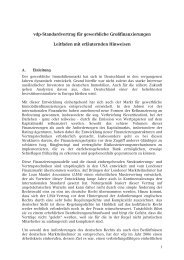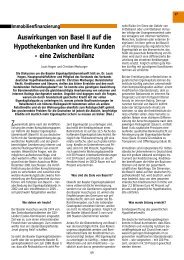The Pfandbrief 2011 | 2012
The Pfandbrief 2011 | 2012
The Pfandbrief 2011 | 2012
Create successful ePaper yourself
Turn your PDF publications into a flip-book with our unique Google optimized e-Paper software.
It is time for new priorities in the regulation of rating agencies in the<br />
European Union. Clear rules for rating agencies’ communications with<br />
market participants and greater transparency on the part of agencies<br />
with respect to the models they use are needed in particular. Currently,<br />
the significance of external ratings for regulatory purposes is also being<br />
scrutinized.<br />
According to the authors, if satisfactory answers to these questions cannot<br />
be found, the approach adopted by the regulators of not interfering<br />
in the methodologies used by the agencies would have to be brought into<br />
question.<br />
Purpose and Objectives of Regulation<br />
<strong>The</strong> crisis in the financial markets was a key factor in the decision also to introduce mandatory<br />
licensing and supervision of rating agencies in Europe. This was accomplished by Regulation<br />
(EC) No. 1060/2009 governing the regulation of rating agencies, which entered into force in<br />
September 2009.<br />
It has been noted that rating agencies were partially responsible for the onset of the crisis<br />
in the financial markets, charging that they had issued inappropriately high ratings for structured<br />
financial products. <strong>The</strong> main reason for this, it is alleged, is that the agencies have a<br />
conflict of interest, in that they receive payments from the very companies they analyse. As a<br />
result, the agencies would have a vested interest in issuing the best possible credit ratings.<br />
75<br />
Avoiding Conflicts of Interest<br />
<strong>The</strong> fact that the Regulation has only been in existence for a short time explains why politicians<br />
and supervisory authorities targeted only a few goals in regulating rating agencies. <strong>The</strong>ir<br />
priorities included improving the quality of the ratings by avoiding conflicts of interest or at<br />
least in disclosing these, if they were unavoidable. Hence, most of the regulatory requirements<br />
in the Regulation are related to the business model and the way the rating agencies are organised.<br />
In addition, the agencies’ registration requirements have become very comprehensive.<br />
Greater Transparency and Greater Competition<br />
Another goal in adopting the Regulation was to increase the transparency of rating agencies.<br />
Among other things, rating companies are required to make their methods, models and<br />
assumptions more transparent and publish extensive historical default rates, for example.<br />
Ultimately, European regulators had intended for Regulation to improve competition. In fact,<br />
the three major agencies, Fitch, Moody’s and Standard & Poor’s (S&P), continue to form an<br />
oligopoly with no real competition. Originally, the first revision of the Regulation governing<br />
rating agencies also focused on promoting competition. <strong>The</strong> EU Commission’s draft version<br />
stipulated that issuers or originators of securitisations should be required to upload all of the<br />
information they have provided to a rating agency commissioned by them onto a password-
















